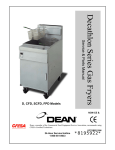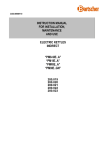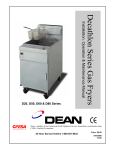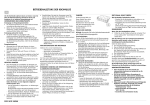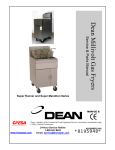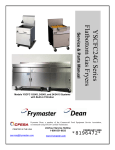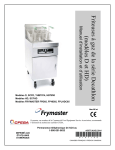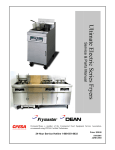Download Dean Cool Zone Series Specifications
Transcript
Dean Equipment •Fryer Serial Numbers Slide Show •Model Number Identification •Model Prefixes •Millivolt Fryers Slide Show •Cool Zone Fryers Slide Show •Triathlon Fryers Slide Show •Flatbottom Fryers Slide Show •Electric Fryers Slide Show •Filtration Slide Show 7-1 Return to Cover Dean Fryer Serial Numbers In the following sections explaining serial number/model number style, shading, underlining, italics and spaces between letters/numbers are used to clearly explain what each number or letter of the serial number/model number denotes. This is for illustration purposes only, and is not found in serial numbers on Dean fryer units. Original Style: Model numbers precede a series of four or five numbers in original Dean serial numbers. This serial number format ended in late-1988, and fryers with these serial numbers are no longer under warranty. 1414— 8479 "W" Prefix Style: In early-1989, Dean Industries changed the serial number format to a series of numbers preceded by a "W", and ending with a suffix of either "SS" or "MS". The model number is not referenced and must be determined. As illustrated below, the first two numbers (shaded dark-gray) represent the month of production. The next two numbers (underlined) indicate the year of manufacture. The remaining series of numbers denote the manufacturing sequence and are not significant. The last two letters (shaded light gray) denotes the material used in vessel construction (SS = Stainless Steel and MS = Mild Steel). W048968724SS 7-2 Single-Letter Style: From early-1994 through mid-1997, Dean Industries used another type of serial number. Serial numbers in this period include a letter after the eighth or ninth number. As illustrated below, the first set of five or six numbers (shaded dark-gray) are the sales order number. The next three numbers (underlined) denote the manufacture order for each individual unit (e.g. 001, 002, etc.). The letter (A— L) preceding the unit number is the month of production, followed by the year of manufacture (shaded light gray). The model number is required to determine material used in construction. An "S" (not shown) at the end of the model number denotes stainless steel construction; no "S" denotes mild steel construction. No information about filtration systems, computer configurations, basket lifts, etc., is contained in the previously discussed serial-number formats. Field service-technicians or store personnel must determine what options are present at the time of service. In some cases, Frymaster Technical Service card files will indicate fryer configuration, but not always. Configuration options must be confirmed at the fryer location as files in the Frymaster Technical Service Department only cover a limited range of serial numbers. 45729001D95 Current Style: Beginning in mid-1997 (current production), Dean Industries revised their serial number format to resemble the Frymaster serial-number system. As illustrated below, the first four digits (shaded dark-gray) indicate the year and month of manufacture (98=1998; 07=July). The two letters in the fifth and sixth position (shaded light gray) denote the class code by fryer. The last four numbers (underlined) denote the manufacturing sequence for that month. 9712GA0001 7-3 Model Number Identification (Except Flatbottoms) Oil capacity (pounds): G = Gas E = Electric 20, 35, 50, 60, 80 SM50G M S SR = Super Runner SM = Super Marathon D = Decathlon T = Thermatron® Controlled M = Millivolt I = Electronic Ignition (24V) HP = High Performance DI = Drop In TC = Counter Top PC = Pasta Cooker BG = Bagel Boiler RG = Rethermalizer S= Stainless Steel No "S"= Mild Steel (* See note below) * Valid only on units with current serial numbers (i.e. ending in "F95"). Dean Model Prefixes (SR) Super Runner Single fryers only, no filter, millivolt only, no basket lifts. (SM) Super Marathon Can be single or multiple fryers, can have filtration, usually millivolt, can have basket lifts. (D) Decathlon Can be single or multiple fryers, can have Electronic Controls (Thermatron® or Computer) can have filtration, can have basket lifts. (TC) Triathalon Counter top fryer. Millivolt or Electronic Control (PC) Pasta Cooker Tube type with Thermatron® Controls (BG) Bagel Boiler Flatbottom with Thermatron® Controls (RG) Rethermalizer Flatbottom with Thermatron® Controls 7-4 Model Number Identification (Flatbottoms) 2424G TI Fry-vessel dimensions, ( i.e. 24" x 24"). G = Gas E = Electric T = Thermatron® Controlled I = Electronic Ignition (24V) 7-5 Return to Dean Table of Contents Millivolt Fryers Super Runner, Super Marathon & Triathlon •General Information •Components •Troubleshooting Super Runner 42 Gas Fryer 7-6 GENERAL INFORMATION The most basic of the Dean fryers are millivolt-operated and thermostat-controlled models. The Super Runner (SR) and Super Marathon (SM) models are essentially alike in operation, with the primary difference being oil capacity and physical size. The table below covers the current production units. MODEL SM20G SM35G SM50G SM60G SM80G OIL CAPACITY 20-23 lb. 35-43 lb. 35-50 lb. 60-75 lb. 80-100 lb. BTU. 50,000 90,000 115,000 150,000 165,000 FRYING AREA 6 ½” x 14” 14” x 14” 14” x 14” 18” x 18” 20” x 20” CONTROLS Millivolt Millivolt Millivolt Millivolt Millivolt Dean also produces a model SR38G (Super Runner), economy gas fryer for light duty applications. MODEL SR38G SR42G SR52G OIL CAPACITY 35-44 lb. 35-43 lb. 35-50 lb. BTU. 90,000 105,000 120,000 FRYING AREA 12” x 14” 14" x 14" 14" x 14" CONTROLS Millivolt Millivolt Millivolt COMPONENTS Gas Valves Millivolt units are equipped with a Robertshaw or Honeywell gas valve. Both valves are powered by a thermopile (or pilot generator) and do not require an external electrical source to operate. The thermopile is also part of the pilot safety circuit. Beginning in March 1994, the Honeywell millivolt gas valve was phased into the Super Marathon Fryer line. Some units (i.e. SM20) may still incorporate a Robertshaw gas valve. The SR38 fryer has been manufactured with the Honeywell gas valve from its inception. 7-7 Honeywell Millivolt Gas-valve Robertshaw Millivolt Gas-valve Pilot Assembly The pilot assembly consists of a pilot orifice, pilot hood, thermopile and mounting bracket. Pilot Hood The pilot serves two functions: 1. Lights the main burners Thermopile 2. Heats thermopile. Mounting Bracket 7-8 Thermostats The Robertshaw or Sunne operating-thermostats used in Dean millivolt fryers are accurate to within approximately 15°F. The manually operated thermostat operates in a range of 200400°F and is used in all Dean millivolt fryers. The high-limit thermostat acts as a safety switch to protect from extremely high oil temperatures. If the oil temperature exceeds the manufacturer’s pre-set temperature of 425450°F, the high-limit will open and de-energize the gas valve. The high-limit thermostat is wired into the pilot-valve coil circuit. When the high-limit switch is open, the gas valve loses power, and both pilot and main burners are extinguished. Gas Pressure With the exception of Triathlon (TC25 and TC35) and the SR38G fryers, Dean millivolt fryers all operate on the same gas pressure, depending on gas type. For natural gas, the valve supplies 4" WC to the burners. For LP (including butane and butane mixtures) the valve is set at 10" WC to the burners. These fryers all require incoming gas pressure in the range of 6-14" WC for natural gas, and 10-14" WC for LP. The burner flame should be a rich, blue color, turning yellow/orange as it goes through the diffusers in each burner tube. Troubleshooting Millivolt Electrical Circuit Troubleshooting There are some basic troubleshooting procedures that will help solve many millivolt fryer problems. Some of the most frequent problems are: 1. Pilot light will not light. Probable causes: no gas supplied to fryer, bad gas valve, or clogged pilot orifice. 2. The pilot light lights, but doesn’t stay lit when gas valve button is released. Probable causes: open high-limit thermostat, low output from thermopile, or bad wire/wiring connections. 7-9 3. Main burner will not cycle ON as oil cools below setpoint. Probable causes: bad thermostat or poor connections/terminal crimps on wires between gas valve and/or other components. Replace crimped-on wire terminals with soldered-on terminals to ensure optimum connections. Corrosion or loose connections in a millivolt system will cause a loss of voltage, which directly affects the thermostat and main gas valve coil operation. 4. Some of the burners don’t ignite. Probable causes: flame holes in the sides of the burner heads are clogged, or the burners may be installed in the wrong position (for example, the right burner only has a flame hole on the left side). 5. Flame rolls out the front of the burners. Probable causes: flue blockage or collapsed flame-diffusers restrict airflow through the heat tubes. Millivolt Circuit: Functional Diagram High Limit Operating Thermostat Gas Valve Main Valve Coil Pilot Coil Thermopile Pilot 7-10 Combination Gas Valve White Thermopile Combination Gas Valve Red Pilot Knob Operating Thermostat TH TH TP Black Black Red Red Safety Valve High-Limit Vent ROBERTSHAW Red Black Red TP Red Red Operating Thermostat Black Yellow (Braided) Orange (Braided) Red Thermopile Red Hi-Limit Black Red Black Black Robertshaw Millivolt Gas Valve Wiring Honeywell Millivolt Gas Valve Wiring Although different in wiring and appearance, both types of gas valves operate similarly in their function. It is also important to note that Dean fryers using Honeywell millivolt gas valves are wired differently than Frymaster Honeywell millivolt gas valves. Although the valves are similar in appearance, the two systems will not work properly unless the correct wiring schematics are followed. 7-11 Return to Dean Table of Contents Cool Zone Fryers Decathlon (D20, D35, D50, D60 D80) & 1414/1818/2020G •General Information •Components •Troubleshooting SCFUD60 with optional Compu-Fry Computer 7-12 GENERAL INFORMATION Dean Decathlon gas fryers are manufactured in a variety of different sizes and capacities. There are also significant differences in ignition and control systems. The Decathlon Cool Zone fryers are tube-type fryers, and may incorporate many combinations of multiple-fryer options (possibly different models in the same battery), automatic basket lifts, and built-in oil filtration systems. Major Decathlon models are listed in the table below: MODEL D20G D35G D50G D50GHP D50GDD OIL CAPACITY 20-23 lbs. 35-43 lbs. 35-50 lbs. 35-50 lbs. 35-50 lbs. BTU. 50,000 90,000 115,000 120,000 115,000 FRYING AREA 6 ½" x 14" 14" x 14" 14" x 14" 14" x 14" 14" x 14" D60G D60G (HP) D80G D80G (HP) 60-75 lbs. 60-75 lbs. 80-100 lbs. 80-100 lbs. 150,000 150,000 122,000 165,000 18" x 18" 18" x 18" 18" x 18" 20" x 20" COMMENTS 2 burners 3 burners 4 burners 4 burners 4 burners (Vessel is 6" deeper than D50G) 5 burners 5 burners 5 burners 5 burners COMPONENTS Temperature Control Systems • • • • • Basic operating-thermostat Solid-state Thermatron® Thermatron® primary with optional thermostat backup Computer (either Dean/Frymaster or Fast computer) Computer with either Thermatron® or thermostat backup Ignition System • Standing pilot with 120-volt gas valve • 24-volt electronic ignition (Pilot lights first, then main burners after the pilot flame is proved.) Gas Valves Decathlon fryers are currently equipped with a Honeywell gas valve, but older units may be equipped with a Robertshaw or White Rogers gas valve. 7-13 Gas Pressure Dean Decathlon fryers require incoming gas pressure in the range of 6-14" WC for natural gas, and 10-14" WC for LP. For natural gas, the valve supplies 4" WC to the burners. For LP (including butane and butane mixtures) the valve is set at 10" WC to the burners. The burner flame should be a rich, blue color, turning yellow/orange as it goes through the diffusers in each burner tube. Burners The easiest way to differentiate between models of Decathlon fryers is to check the dimensions of the cooking area and/or the number of burners/tubes. As seen in the table on the previous page (there are exceptions), most models are different in size and the number of burner/tubes contained. The burners, which are similar in appearance in a given model, are actually manufactured as either left, right or center versions. For example, a D20 will have a left and a right burner. A D60 with five burners will have a left burner, three center burners and a right burner. It is essential that the burners be installed in the correct location. If more than one is removed at a time, they should be marked appropriately for re-installation. Failure to install the burners correctly will result in some burners failing to light properly, or not at all. Pilot Assembly The pilot assembly for the 120-volt gas valve unit is constructed the same as that used in millivolt fryers and accomplishes the same function. Electronic Ignition The igniter for the 24-volt ignition system is slightly different from the standard pilot assembly. A flame-sense rod replaces the thermopile in electronic ignition assemblies. Cool Zone Ignitor 7-14 Cool Zone Flame-Sense Rod D20 D.S.I. Pilot Assembly Temperature Controls The Robertshaw or Sunne operatingthermostat and high-limit thermostat used in these fryers are the same components used in the Super Marathon millivolt fryers. In the Decathlon series however, the highlimit thermostat is normally wired in series with the gas valve main coil, instead of the pilot coil. When the high-limit switch opens, it cuts power to the gas valve, and extinguishes the main burners. Operating-Thermostat High-Limit Many Decathlon fryers use a solid-state temperature controller, or Thermatron® controller instead of the basic thermostat. A Thermatron® system incorporates a temperature-control circuit board, a potentiometer, and a temperature probe. This system is more accurate and more reliable than a standard thermostat, but is also more expensive to purchase, repair or replace. The temperature probe is different from the operating-thermostat in that it is much thinner, and is the same diameter its whole length. Unlike a standard thermostat, a Thermatron® probe works by comparing resistance through the probe circuit to the resistance set in the potentiometer (which corresponds to desired temperature). To check controller and probe accuracy, it is necessary to measure the probe circuit resistance with an ohmmeter and measure the actual oil temperature. 7-15 Dean has used two different styles of Thermatron® control boards, an old style and a newer style. Old-style Thermatron® interface board Old-style Thermatron® control panel New-style Thermatron® interface board New-style Thermatron® control panel The old-style Thermatron® system can be easily identified by a push-button test switch on the control panel (probe test button). The probe wires, one black and one white wire, are also an indicator of old-style systems. (Note: The black and white wires are attached to the probe itself, and not to the interface board). A replacement temperature-sensor probe is available for old-style systems, but the interface board is not. If the old-style interface board fails, the complete system must be retrofitted with the new-style "G0" Thermatron® system. 7-16 The new "G0" Thermatron® system can be identified by the absence of a test button on the controller. Also, both wires connected to the probe are either dark brown or black. None of the parts for the two systems are interchangeable. The temperature/resistance characteristics are very different for each probe and the corresponding circuit board. Some Cool Zone fryers, especially for some major restaurant chains like Chili’s, may use a computer control system. It replaces the Thermatron®, and functions similarly while adding cook cycle timing and temperature/timing sensitivity. The computer temperature probe looks similar to the Thermatron® probe, but is much different in resistance. Confirm the system type installed into the unit when servicing or ordering parts. For the temperature vs. resistance readings on the probes, refer to the charts in the appropriate section. Dean electronic ignition fryers incorporate a variety of ignition modules. Decathlon fryers have been manufactured with Robertshaw ignition modules, which sense flame through a separate flame-sensing wire. The Honeywell module senses flame through the high-voltage wire. Either of these Robertshaw modules is acceptable for use in Decathlon fryer systems. The Honeywell ignition module senses flame through the highvoltage wire. The modules above are examples of the "dual-stage" ignition module. An electronic spark lights the pilot, then the main valve opens after the pilot flame is "proved". The Robertshaw dual-stage ignition module is currently the only module used. The Honeywell dual-stage module should not be used at this time due to occasional problems with inconsistent ignition. 7-17 7-18 TEMP SENSOR 1 2 1 2 1 2 3 4 1 2 3 4 POT 1 2 3 4 1 2 3 4 GAS VALVE 5 6 5 6 PV MV MV/PV GND IGN TR SEN TH OPTIONAL BOIL OUT SWITCH C 1 2 3 4 5 6 7 8 9 RELAY R1 120 VAC 4 2 31 POWER SWITCH 14 3 7 8 9 10 11 12 TEMP SENSOR 120 VAC "GO" SOLID STATE TEMPERATURE CONTROLLER 13 2 1 1 2 3 4 5 6 7 8 9 1 2 3 4 5 6 7 8 9 IGNITION MODULE 115 VAC POWER SUPPLY 1 2 3 4 5 6 7 8 9 SENSOR IF INSTALLED, BOIL-OUT CIRCUIT WILL BE DUPLICATED FOR BOTH THERMATRONS BACK-UP OPERATING THERMOSTAT 115V 24V IGNITOR HI-LIMIT THERMOSTAT LEFT FRYER 1 2 1 2 1 2 3 4 1 2 3 4 POT ON-OFF-0N POWER SWITCH 1 14 3 7 8 9 10 11 12 120 VAC "GO" SOLID STATE TEMPERATURE CONTROLLER 13 2 1 2 3 4 5 6 7 8 9 1 2 3 4 5 6 7 8 9 RELAY R2 120 VAC 5 AMP FUSE BACK-UP OPERATING THERMOSTAT 1 2 3 4 5 6 7 8 9 1 2 3 4 5 6 7 8 9 24V GAS VALVE SENSOR IGNITOR IGNITION MODULE P/N 1906 24V 120 VAC GAS VALVE PV MV MV/PV GND IGN TR SEN TH IGNITION MODULE MV MV/PV PV GND GAS VALVE (ALTERNATIVE - USED ON OLDER UNITS NO LONGER USED) IGNITOR 115V HI-LIMIT THERMOSTAT 115V 24V 4 2 31 POWER SWITCH RIGHT FRYER Wiring Diagram for 2-vat Decathlon Fryer with Thermatron® Controls TROUBLESHOOTING Pilot Malfunctions 1. Pilot fails to light. a. Gas valve on? b. Check pilot burner adjustment. Adjust pilot flame to extend about 1/2" above the top of the pilot burner. c. Check pilot gas line and pilot burner orifice for blockage. 2. Pilot will not stay lit after gas valve knob is released. a. b. c. d. Check that thermopile wires are tightly attached at gas valve. Pilot flame adjustment too low. Pilot flame not in good contact with thermopile due to drafts or make-up airflow. Thermopile defective. 3. Pilot flame goes out when burners come on. a. Pilot flame is too low even though it looks OK. Adjust higher. b. Incoming gas volume may be low. Check incoming gas connection and supply. 4. Pilot flame is proper size but unstable. Flame waivers or does not envelop the thermocouple completely. Check for drafts caused by air conditioning equipment or make-up air. Main Burner Malfunctions 1. Main burner will not come on – no gas present at main burner. a. b. c. d. e. f. Gas valve open? Check pilot light. Bad gas valve? Defective high-limit? Drain valve closed completely? Check reset switch also. Check probe if Thermatron®-equipped. 2. Main burner flames are small and lazy – oil heats slowly. a. b. Gas pressure below specifications. (4" W.C. for natural gas, 11" W.C. for LP). Restriction in flue. 7-19 3. Signs of excessive temperature - oil scorched/discolored. a. b. c. d. Check thermostat calibration. Gas pressure above specifications. Shortening is of inferior quality or used too long. Short circuit. Check wiring and harnesses. 4. Fryer fails to reach setpoint or runs erratic. a. Incorrect location of sensor probe or defective probe. b. Operating-thermostat or Thermatron® controller defective. 5. Fryer comes on when reset switch on drain valve is pressed, but instantly goes out when reset switch is released. Drain-valve microswitch is not positioned properly or is defective. 6. Fryer temperature cannot be controlled - runs to high limit temperature. Defective Thermatron® controller or operating-thermostat. 7-20 Return to Dean Table of Contents Triathlon Fryers TC25 TC35 •General Information •Components •Troubleshooting Triathlon TC-25 Millivolt Fryer 7-21 General Information The Dean line of countertop fryers consists of two fryers, the TC25 and TC35. The models are very similar in appearance, but quite different in operation. They have two significant differences. The TC35 has five burner tubes, and may utilize 120VAC for power. The TC25 has only four burners and is strictly a millivolt fryer – it does not utilize 120VAC. MODEL TC25 TC35 OIL CAPACITY 25 lb. 35 lb. BTU. FRYING AREA 12.5" x 14" 14" x 17" 72,000 90,000 COMMENTS Millivolt Millivolt/120V Thermatron® COMPONENTS Gas Valves Triathlon units are equipped with a Honeywell gas valve (natural gas), or a Robertshaw valve (LP gas). The millivolt units are powered by a thermopile (or pilot generator) and do not require an external electrical source to operate. The thermopile is also part of the pilot safety circuit in the 120VAC units. Gas Pressure Dean Triathlon fryers operate at the same gas pressure, depending on gas type. Triathlon fryers require incoming gas pressure in the range of 6-14" WC for natural gas, and 10-14" WC for LP. For natural gas, the valve supplies 4" WC to the burners. For LP the valve supplies 10" WC to the burners. The burner flame should be a rich blue color, turning to yellow/orange as it goes through the diffusers in each burner tube. Burners The incoming gas flows through orifices and is ignited at the front end of each tube by the standing pilot. Internal diffusers slow the flame as it goes through the burner tubes. This slower and more turbulent flame gives a much better heat transfer to the walls of the tubes, thereby heating the oil more efficiently. Location of standing pilot 7-22 Pilot Assembly The pilot assembly for the Triathlon systems is the same as that used in Dean millivolt fryers and accomplishes the same function. Thermostats The operating-thermostat and high-limit used in the Triathlon fryers are the same as those used in Dean Super Marathon fryers. Some of the TC35 fryers are operated by 120VAC, and use the Thermatron® temperature controller instead of the basic thermostat. Triathlon Thermatron® units are not the same as standard gas Thermatron® units, but do incorporate the same system components. Both systems use a standing pilot light, which must be lit manually for operation. The differences are in the gas valve voltage and the valve control system. WHT BLK 2 AMP FUSE GRN 115V POWER SUPPLY POWER SWITCH SPST ORG HIGH-LIMIT 4 BLK ORG ORG BLK WHT WHT BRN WHT 2 3 4 5 6 7 8 9 1 2 3 4 5 6 7 8 9 2 2 1 2 3 4 ORG 1 ALTERNATE THERMOSTAT RED 1 BLK 2 PIN CONNECTOR (AMP) WHT G5RD7 THERMOSTAT ORG TC35 Thermatron System with 120V Gas Valve 7-23 120 V GAS VALVE 5 6 7 8 9 RED TEMP SENSOR 1 BLK WHT GRN ORG WHT BLK WHT ORG BRN WHT BRN 1 WHT 3 BLK 2 LIGHT THERMOCOUPLE TROUBLESHOOTING 1. Pilot fails to light. a. b. c. d. Check gas line connection. Check safety shut-off valve. Excess air in gas line. Bleed line. Depress pilot knob for at least one minute when lighting. 2. Pilot fails to remain lit. a. b. c. d. e. Check thermopile leads to ensure leads are connected to gas valve. Re-light pilot by depressing the pilot knob for longer period of time. Adjust pilot flame height. Debris or excess air in gas line. Verify incoming gas pressure. Minimum readings are 3.5" WC (8.71 mbar) for natural gas and 10" WC (25 mbar) for propane. 3. Fryer fails to heat fry vessel. a. Ensure gas valve is ON. b. Set operating-thermostat temperature to 350°F (177°C). Verify that main burners light. c. If burners fail to light, suspect gas valve. 4. Fryer fails to maintain set temperature. a. Ensure gas valve is ON. b. Set operating-thermostat to 350°F (177°C) and observe main burners. c. If burners light, allow fryer to heat vessel and check calibration of operatingthermostat. 5. Fryer runs quickly to high temperature (higher than 400°F/205°C) and remains there. a. Faulty operating-thermostat. 6. Fryer temperature is erratic. a. Check location of temperature probe. If probe is loose, allow fryer to cool, then reattach probe to heater tube. b. If probe was attached properly, faulty probe or operating-thermostat. 7-24 Return to Dean Table of Contents Flatbottom Fryers 1824G 2424G •General Information •Components •Troubleshooting Dean 2424 Flat Bottom 7-25 GENERAL INFORMATION MODEL 1824G (T) OIL CAPACITY 45-70 lb. BTU 120,000 FRYING AREA 18" x 24" 2424G (T) 65-90 lb. 120,000 24" x 24" CONTROLS Thermostat (or Thermatron®) Thermostat (or Thermatron®) Dean Flatbottom fryers are unique in the Dean line. They are the only units that incorporate draft-inducers, or blowers to move combustion air through the burners. The blower is mounted in the exhaust flue area and operates by pulling air through the burners. This air movement directs the combustion products back and forth across the underside of the flatbottom vessel through a series of baffles, thus facilitating even heat transfer. Because the draft-inducer operates only during the combustion cycle, cold air is prevented from entering the combustion chamber and cooling the oil during the coasting or non-heating cycle. Temperature Control Options • Standard operating thermostat. • Solid-state Thermatron® control. • Thermatron® primary control with thermostat backup. Ignition System Options • Standing pilot with 120VAC gas valve. • Direct spark ignition with 24VAC gas valve. Direct Spark Ignition Igniter 7-26 The Honeywell direct-spark ignition module is used in Dean flatbottom 1824 and 2424 gas fryers with direct-spark ignition. This module operates differently from the dual-stage modules previously discussed, and cannot be used to replace faulty dual-stage modules. Although similar to the Frymaster ignition module, the Dean Honeywell direct-spark module lacks an "Alarm" terminal. The Dean Honeywell module should have stickers on the top or bottom identifying it as an 11second module. The Frymaster and Dean Honeywell modules are not interchangeable. Honeywell Direct-Spark ignition module COMPONENTS Pilot Assembly The pilot assembly is constructed the same as pilot assemblies covered in the Millivolt Fryer section. Gas Valves Flatbottom fryers may use either a Robertshaw or Honeywell gas valve. Normally, the 120VAC version uses a Robertshaw valve, and the 24VAC electric ignition version uses a Honeywell valve. In the 24VAC version, the temperature-control circuit powers a 120/24VAC transformer, which powers the module and gas valve. Although there is no actual pilot assembly, the igniter and flame sensor assembly is often mistaken for a pilot assembly. The 120VAC valves use a thermopile as part of a safety circuit much like a millivolt valve. If the pilot is not lit, the gas valve will not open. 7-27 Burners The flatbottom fryers each have three burner tubes. Each burner has its own orifice, but all three burners go into a single burner/heat diffuser area under the fry vessel. The flame is drawn through the diffuser/baffle area where the heat is transferred to the bottom of the vessel, thus heating the oil. Front Oil Drain Front view of burner area Flame Baffles Temperature Control Systems The Thermatron® control system is the standard temperature-control system and may be used with either the standard 120VAC-gas valve or 24VAC electronic ignition. See the Millivolt Fryers section for a detailed description of the Thermatron® control system. The standard Robertshaw or Sunne operating-thermostat and the high-limit thermostat used in these fryers are the same components used in the Super Marathon millivolt fryers. The operating-thermostat control system is not very common, and is usually found in older fryers. In Dean Flatbottom fryers, the high-limit thermostat is wired in series with the gas valve main coil in a 120VAC system, or on the primary side of the 120/24VAC transformer in a 24VAC ignition system. When the high-limit switch opens, the gas valve or the 24VAC transformer loses power and shuts off the main burners. 7-28 Gas Pressure Dean Flatbottom fryers require incoming gas pressure in the range of 6-14" WC for natural gas, and 10-14" WC for LP. For natural gas, the valve supplies 4" WC to the burners. For LP (including butane and butane mixtures) the valve is set at 10" WC to the burners. Wiring Schematic 115V POWER SUPPLY HIGH-LIMIT THERMOSTAT 2 AMP FUSE POWER SWITCH MOTOR AIR PROVER DSI IGNITION MODULE 1 1 2 115V POWER SUPPLY 2 3 3 4 4 24V 115V 2 AMP FUSE HIGH TENSION LEAD 9-PIN CONNECTOR MOLEX POWER SWITCH POT SPARK IGNITER FLAME SENSOR GAS VALVE OPTIONAL 1 2 3 GAS VALVE 4 120 VAC 120 VAC 120 VAC 24 VAC 2-PIN CONNECTOR AMP RESET SWITCH LIGHT RED "G0" SOLID STATE TEMPERATURE CONTROLLER COIL RELAY THERMOCOUPLE TEMPERATURE SENSOR VALVE SWITCH SAFETY SWITCH IF USED In the 24VAC electric-ignition models, 120VAC from the control circuit passes through the sail switch, the high-limit thermostat, and the 120/24VAC transformer to the spark module. The module opens the gas control valve and causes the igniter to spark for a predetermined time. The spark will stop at the end of the predetermined time regardless of burner ignition. The Thermatron® controller or the operating-thermostat controls the system as long as the flame sensor detects the flame. In the 120VAC models, a similar power flow occurs. The main difference, other than the standing pilot, is that the control circuit voltage energizes the 120VAC gas-valve main-coil directly after passing through the blower, the sail-switch, and the high-limit thermostat. The Dean Flatbottom fryers may be controlled in a variety of ways. Because models 2424G and 1824G look almost the same in any configuration, it is essential to determine the type of ignition and temperature control system for proper troubleshooting and repair. 7-29 TROUBLESHOOTING Pilot Malfunctions 1. Pilot will not come on at all. a. Gas valve on? b. Check pilot gas line and pilot burner orifice for blockage. 2. Pilot will not stay lit after gas valve knob is released. a. b. c. d. Check that thermopile wires are tightly attached at gas valve. Pilot flame adjustment too low. Pilot flame not in good contact with thermopile due to drafts or make-up airflow. Thermopile defective. 3. Pilot flame goes out when burners come on. a. Pilot flame is too low even though it looks OK. Adjust higher. b. Exhaust blower airflow is blowing out flame. Adjust higher. c. Incoming gas volume may be low. Check incoming gas connection and supply. Main Burner Malfunctions 1. Main burner will not come on – blower running. a. b. c. d. Gas valve open? Bad gas valve? Defective high limit? Blower sail (air-prover) switch defective or not actuating? 2. Blower not operating, although oil temp is below setpoint. a. b. c. d. Defective Thermatron® temperature probe. Foreign material blocking fan wheel. Defective safety circuit component (if so equipped) or circuit not properly reset. Blower motor overheated and tripped thermal overload (auto-resets in approx. 30 minutes). 3. Main burner flames are small and lazy – oil heats slowly. a. Gas pressure below specifications. (4" W.C. for natural gas, 10" W.C. for LP). b. Restriction in flue. 7-30 Return to Dean Table of Contents Electric Fryers Super Runner 38 Electric, 1414/1818/2020E, 18UE/18E/14E, EH1721 •General Information •Components •Troubleshooting Super Runner SR38E 7-31 GENERAL INFORMATION The Dean Electric fryers are divided into two main categories. The SR (Super Runner) and Cool Zone models comprise the first category. The SR38E is an economy fryer with thermostat controls. The Cool Zone models are all essentially alike in design, with the primary differences being size, power usage, and oil capacity. Although 208VAC is the standard voltage, the Cool Zone fryers are also available in 240 VAC, 480 VAC, and other voltages used internationally. The table below lists the current production units. MODEL SR38E OIL CAPACITY 20-23 lb. 714E 1414E 1818E 22-28 lb. 40-55 lb. 70-85 lb. 2020E 95-110 lb. 18UE 84-103 lb. * Indicates high performance kW FRYING AREA 12.0 / 14.0 / (21.0 HP*) 9.0 18.0 13.5 / 18.0 / (21.0 HP*) 13.5 / 18.0 / (21.0 HP*) 17 / 20.5 12" x 14" PRIMARY CONTROLS Thermostat 6 3/4" x 14" 14" x 14" 18" x 18" Thermatron Thermatron Thermatron 20" x 20" Thermatron 18" x 24" Thermatron The second category of electric fryers includes a pair of flatbottom fryers, differing only in size and oil capacity. These are essentially the same operationally as the Cool Zone fryers, but structurally different because they are designed to cook a different of product. MODEL 1824E 2424E OIL CAPACITY 35-43 lb. 65-95 lb. kW FRYING AREA 19.0 19.0 18" x 24" 24" x 24" PRIMARY CONTROLS Thermatron Thermatron COMPONENTS Fixed Elements All Cool Zone and Super Runner fryers, with the exception of the Model 714, have three identical elements. The Model 714 has only one element. It is, however, a higher-rated element than the elements used in Dean electric fryers. The flatbottom models also have three heating elements. The middle element is different from the side elements in electric Flatbottom fryers. The side elements are often hard to see 7-32 since they are normally under protective guards on each side of the vessel. The side elements are identical, and have the same part number for both the left and right side. The elements in both types are normally wired for three-phase power, but may be wired single-phase if permitted by local electrical code and the wire size is adequate. Unlike the Frymaster electric elements, most Dean elements do not tilt, or lift out of the frypot. They are mounted through the front wall of the vessel. The notable exception are the Ultimate Electric (UE) models which have Frymaster-type tilting elements. Ultimate Electric Models Ultimate Electric fryers use a tilt-element system similar to Frymaster's electric fryers. The Dean 18UE fryer is a new style fryer manufactured by Dean Industries. Originally built for KFC, it is now being sold to other restaurants. It is a high-volume fryer with a built-in filtration system. The frypot design differs from all other Dean designs. Production began in October 1998, with several prototypes in service in various parts of the world. It incorporates a combination of Dean and Frymaster technology, including Frymaster components such as elements and controllers. Dean has built other tilt element fryers based on the 18UE prototype. KFC and Taco Bell use the 18E and 14E fryers. The 18E is essentially a 18UE fryer with a KFC-1 Computer and KFC-style drain system. KSCFH18E Electric Fryer The 14E has a 14" x 14" cooking area, while the 18E has an 18" x 18" cooking area. A third 18UE variant is the Frymaster EH1721 fryer that shares many common components with the original 18UE. 7-33 Internal Operations and Systems Two contactors, one latching and one heating, control the power to the elements. The latching contactor engages when the main power switch is turned on. Power is also supplied to the thermostat or Thermatron® circuit board. The heating (or cycling) contactor energizes as the thermostat or Thermatron® calls for heat. If the high-limit thermostat opens, power is cut to the coil of the latching relay and to the thermostat or Thermatron® control system. Most Dean fryers with built-in oil filtration systems also incorporate a safety-reset system (this does not apply to the 18UE fryers). It consists of a power switch, a momentary reset switch, a drain-valve mounted microswitch and a relay. When the drain valve is opened, the microswitch opens, de-energizing the relay and shutting off power to the Thermatron or thermostat. For morning start-up, or to reset the system, turn the power switch on, then ensure that the drain valve is fully closed (microswitch activated). Press the reset switch momentarily to the "ON" position, which will energize the relay and route voltage to the temperature controller, heat light and heating contactor-coil. Wiring Diagrams HIGH-LIMIT POWER SWITCH LATCH CONTACTOR K2 K1 HEATING CONTACTOR FUSE 5 AMP 1 3 5 2 4 6 240V 24V THERMOSTAT TERMINAL BLOCK P/N 1501-1 6 4 2 5 3 1 GROUND TERMINAL SR38E Wiring Diagram 7-34 120VAC POWER SUPPLY 4 2 FUSE 3 1 HEATING ELEMENTS POWER POWER SWITCH SWITCH 1 HIGH- LIMIT THERMOSTAT 2 3 4 120VAC K2 K1 2 FUSE 5 AMP 3 1 COIL 3 5 2 4 6 4 RESET 4 CONTACTORS 1 24VAC SWITCH 1 2 6 3 DRAIN VALVE SWITCH OPTIONAL THERMOSTAT 1 2 3 4 5 6 7 8 9 1 2 3 5 6 7 8 9 FUSE BLOCKS POT OPTIONAL DRAIN VALVE SAFETY CIRCUIT 1 1 2 3 4 1 2 4 2 3 4 5 6 7 8 9 4 6 4 2 5 3 1 1 3 L3 L2 L1 2 LINE VOLTAGE 3 7 FILTER SWITCH 8 9 10 11 12 CIRCUIT BREAKER "G0" SOLID STATE TEMPERATURE CONTROLLER GROUND TERMINAL 13 14 TEMPERATURE SENSOR HEATER - 50 WATT T5 T4 T8 T3 T2 T1 MOTOR TO CHANGE DIRECTION OF ROTATION, SWITCH LEADS T5 & T8 ON MOTOR FILTER CIRCUIT Dean Basic Electric Wiring Diagram 208V OR 240V ELEMENTS L 1 2 3 4 5 6 1 2 3 BRN 4 5 6 7 8 9 R BRN BLU K1 K2 LATCH CONTACTOR HEAT CONTACTOR BLK#2 BLK#2 WHT#2 WHT#2 WHT WHT WHT BLK#2 BLK#2 BLK#2 T1 FUSE T2 FUSE 1 BLK#2 240V 240V (208V) (208V) 24V BLK#2 3 5 2 4 6 WHT#2 GROUND TERMINAL 12V BLK#2 WHT#2 YEL#2 HI-LIMIT THERMOSTAT DRAIN C6 C 4 WIRE BLU NC MICROSWITCH BLK RED RED WHT WHT RED BLK RED RED RED 6 3 PHASE 2,4,6 L4 4 2 BLK RED 5 L3 TERMINAL 3 L2 240V ONLY 1 L1 5 BLOCK 3 1 RED 2 3 4 5 6 7 8 9 10 11 12 1 WHT TEMP PROBE J2 1 2 3 4 5 6 7 8 9 10 11 12 3 WIRE 3 PHASE COMPUTER INTERFACE GND 6 BOARD 3,6 L3 4,5 L2 1,2 L1 3 4 5 1 2 3 4 5 6 7 8 9 10 11 12 13 14 15 2 1 TO COMPUTER 18UE Electric Fryer With Computer 7-35 TERMINAL BLOCK TROUBLESHOOTING 1. The most frequent problem is that the fryer will not heat at all. First, ask these questions: a. Is the fryer plugged in (three-phase plug)? b. Is the three-phase circuit breaker tripped? c. Is the drain valve microswitch activated (if so equipped)? If so, reset safety switch. 2. If those are OK, next check the temperature control circuit. a. With unit calling for heat, is there power going into the thermostat/Thermatron board? b. If there is no power going into the Thermatron or thermostat, check the safety circuit for defects in the microswitch and relay. c. Power in but not out usually indicates a defective thermostat or temperature probe if the device is set for a temperature higher than the actual oil temp. Check for continuity/resistance through thermostat or temperature probe. (See applicable resistance chart for Thermatron.) d. If the Thermatron probe checks OK, the difficulty is probably in the solid-state “G0” board. 3. If the fryer heats, but somewhat more slowly than it should, the most probable causes are: a. Improper incoming voltage. b. You may not have all three phases of power to fryer (if three-phase unit). c. One or more elements may be defective. d. Heat contactor may not be closing properly on all three contacts. 4. The fryer heats OK sometimes, but occasionally won’t come back on, and the oil cools below setpoint. a. If unit is thermostatically controlled, probable cause is a defective thermostat. b. On Thermatron-controlled fryers, probable cause is the solid-state circuit board. 7-36 Return to Dean Table of Contents Filtration Super Cascade; Under Fryer Filter; Cascade; Single Under Fryer Filter; Micro-Flo/Built-In and Micro-Flo Portable Filters •General Information •Systems/Components •Troubleshooting Dean Under Fryer Filter (UFF) Filtration System 7-37 General Information Dean manufactures four major types of oil/shortening filtration systems. Each system is unique in design and appearance, but all accomplish the same job. The filtration systems, with a couple of notable exceptions, have the same basic components for the filtration process. Each incorporates a main filter pan, with a filter screen or grid on the bottom of the filter pan. On top of the filter screen, filter paper and filter powder are placed. The paper is held in place by a clamp or hold-down ring. Many units have a crumb basket to catch the larger pieces of sediment (not shown). It is important that the filter pan cover be installed before operating the filter system. Filter Paper Hold-down Ring Filter Pan Cover Filter Paper Filter Screen (always ensure that screen is present before inserting filter paper) Filter Pan Assembly Typical Filtration System Components 7-38 Super Cascade Filter (SCF) Super Cascade filter systems are installed into batteries of two or more fryers. It fits under two fryers and does not take up any additional floor space. If there are more than two fryers in the battery, the filter system is normally under the outermost fryers on either end. On old-style systems, the pump and motor are built into the fryer, and the filter unit couples onto the pump with a quick-connect coupling. Super Cascade systems are commonly seen in restaurant chains such as Chili’s Grill, IHOP, and some Long John Silver’s restaurants. Magnum Filter Leaf Assembly Old-style Super Cascade Filter System An optional “Magnum Leaf Filter Assembly” is available for use on Super Cascade filter systems. It replaces the normal bottom grid, filter paper, hold-down ring, and regular quickconnect with a permanent double-screen filter and standpipe system. The screen assembly is removable for cleaning, and does not use standard filter paper and powder. This option’s benefits include the elimination of the cost and problems often associated with paper and powder systems. 7-39 Cascade Filter (CF) The Cascade filter system is designed to fit under single fryers, either in a battery or as a stand-alone fryer-filter unit. Cascade filter units do not require additional floor space. If the filter is part of a battery, it always is installed under the fryer on the right end. The filter pump and motor are built into the front of the filter assembly. The unit is selfcontained, just requiring a power receptacle. A "CF-ready" fryer has a receptacle for the filtration built into the fryer. The filter unit can be moved from one "CF-ready" fryer to another, allowing the user to filter several fryers with one filter unit. The CF unit can also function as a portable filter unit when used with the optional hose and nozzle assembly. Under Fryer Filter (UFF) Beginning in 1999, Dean introduced a new Super Cascade Filter model, often referred to as the Under Fryer Filter (UFF). The design incorporates a new oil return system modeled after Frymaster's FootPrint III. Oil is returned to the fryer by an oil pickup tube (mounted on the fryer's front channel) inserted into a filter pan connector. The filter-pump motor is activated by either a yellow pull-handle (similar to the old system), or by a flat, red handle located under Oil Pickup Tube the fryer control panel. Filter Pan Coupler New-style Filter Pan Connection Under Fryer Filter systems may have a blue pull-handle, which operates an optional drain flush system. Optional blue pull-handle on UFF systems. 7-40 Single Under Fryer Filter (SUFF) Single Under Fryer Filters (SUFF) are designed differently from earlier Cascade Filters (built before late-1999). The new design couples to the oil return system similarly to the new Under Fryer Filter system. Also, the filter pump and motor are in the fryer cabinet. Micro-Flo Filters (MF-90 Series) BUILT-IN FILTER SYSTEMS (BI) Micro-Flo filter systems are very similar to the Frymaster Filter Magic system. Micro-Flo built-in filter systems are built into a cabinet matching fryer size and appearance, and are normally attached to either side of a single or multiple-battery (up to five) fryer. The filter system cabinet may also be installed between fryers in a battery. The motor and pump are mounted in the fryer, and the filter pan slides in on rails under the motor/pump assembly. The holddown ring normally has latching handles to secure the ring to the filter pan. Built-in filter systems come in a variety of sizes, and are available attached to almost any model. Usually the filter cabinet has a food warmer and dump station built into it above the filter portion. Micro-Flo Filter System (MF-90) Micro-Flo Built-In Filter Systems MODEL NUMBERS APPLICATIONS MF90-12A/15MC SM20G, SM35G, SM50G, D20G, D50G, 714E, 1414E MF90-12B/15MC (Low Profile) SM20G, SM35G, SM50G, D20G, D50G, 714E, 1414E MF90-18A/20MC 1824G, 2424G, 1824E, 2424E MF90-20A/20MC SM60G, SM80G, D60G, D80G, 1818E, 2020E, 18UE 7-41 Portable Filtration Systems Portable filters are manufactured as suction/return or suction-only models. The more common type is the “suction/return” unit. The motor/pump is reversible and allows use of the filter with all fryers with or without a front oil drain. The control switch has three positions: IN— OFF— OUT. “Return-only” models are exclusively for gravity-draining fryers. The control switch has two positions: OFF— RETURN. Portable filtration units are designed as standalone equipment and may be used with nonDean fryers. Many restaurants, including Burger King restaurants, use Dean portable filtration systems, but do not use Dean cooking equipment. In 1999, Dean began building the PF95-LP as a replacement for Frymaster's model PF90 filter. Arrows show direction of oil flow Oil Return Hose Fryer Vessel Drain Valve with Extension Quick Disconnect Filter Pan Pump Portable Filter System Oil Flow Micro-Flo Portable Filtration Systems— Suction / Return Models MODEL NUMBER CAPACITY MF90AU/65 65 lbs. MF90AU/80 80 lbs. MF90AU/110 110 lbs. (Also in low profile) Micro-Flo Portable Filtration Systems— Return-Only Models MODEL NUMBER CAPACITY MF90U/65 65 lbs. MF90U/80 80 lbs. MF90U/80 LP 110 lbs. (Low profile filter tank) PF95-LP 110 lbs. (Low profile filter tank) (Replaced Frymaster PF90 filter) MF90U/110 110 lbs. MF90U/160 160 lbs. MF90U/172 172 lbs. 7-42 Portable filter systems employ a hose/wand assembly to return filtered oil to the fry vessel. It is also used to rinse remaining sediment out the drain valve to prevent clogging and filteredoil contamination. Suction/Return units also use the hose to suck the oil out of the vessel. When using the suction feature of a portable filter system, it is essential to keep the tip of the filter hose wand out of the sediment in the bottom of the fryer. Although there is usually a filter screen on the tip of the wand, sediment may be sucked into the unit and clog the pump. If this occurs, the pump must be taken apart and cleaned. With either version, it is best to gravity drain the oil out into the filter pan if possible, then use the return hose/wand assembly to flush remaining sediment out the drain valve and into the filter unit. It is essential to know which model of filter system you are servicing, especially when requesting parts. Usually, MF90 is the model number on the data plate, regardless of type of filtration system. The TYPE number, which is normally in a separate block on the data plate, is extremely important in obtaining the correct replacement parts and filter paper. For example, a given model number might be MF90AU/80. AU/80 is the TYPE. If the TYPE is unavailable, get the model/capacity of the associated fryer(s), and the dimensions of the filter tank. Sometimes, the size of the filter paper being used, or the dimensions of the filter grid/channel assembly is enough to establish the model/type of filter. PROPER FILTRATION SYSTEM USE Correct installation and proper use of the filter paper is essential. When filtering, observe the following basic steps: 1. Start with a clean filter pan assembly. 2. For units using the standard paper and powder system, follow instructions below. If the Magnum Leaf Filter is in use, follow the instructions accompanying the filter system. 3. If Dean filter paper is used: a. With paper support screen/grid assembly on the bottom, install two sheets of Dean filter paper, one on top of the other. b. Install the hold-down ring assembly. c. Sprinkle 16 oz. of filter powder evenly over the filter paper. 4. If Frymaster filter paper is used: a. With paper support screen/grid assembly on the bottom, install one sheet of Frymaster filter paper. b. Install the hold-down ring assembly. c. Sprinkle 8 oz. of filter powder evenly over the filter paper. 7-43 5. If time permits, dampen the powder with hot oil (either by draining some out of the first vessel or by scooping some out of a vessel) and turn the filter pump on momentarily. This ensures a good seal between the paper and the filter screen/grid. 6. Proceed with normal filtration operation. 7. If filtration seems slow after filtering two or three vats, inspect the paper. Clean off excess sediment build-up, or replace top sheet of paper if necessary. 7-44 Wiring Diagrams Super Cascade Filter 120VAC Power Supply WHT BLK GND WHT WHT BLK PUR BLK To LH Fryer Circuit BRN RED YEL Fuse Fuse RED BRN BRN CB ORG 120VAC/12VAC Transformer WHT BLU Circuit Breaker Fuse 20 Amp BLK YEL PUR YEL 120V Manual Bypass Switch BLU WHT ORG RED 12V To Fryer Controls 120VAC/12VAC Transformer RED 24V 120V RED NC NO COM BLU NC NO COM YEL YEL YEL DPDT 24VAC Relay PUR RED YEL#1 YEL YEL RED DPDT 24VAC Relay 24V BLU 24V YEL YEL#1 PUR YEL RED 2 1 2 1 NC COM NO Oil Return Microswitch 7 Amp Circuit Breaker CB T1 T5 SPST Toggle Switch T4 T8 Motor Terminal Box 7-45 GRN Cascade Filter without Heater WHT BLK 120VAC Power Supply Wiring Diagrams (cont.) Cascade Filter with Heater BLK 7 Amp Circuit Breaker GRN WHT 120VAC Power Supply CB Heater ON Pump ON T5 T4 SPDT Toggle Switch Probe Heater T1 T8 Motor Terminal Box MF90-BI with Heater HG N BLK 3 5 2 WHT Ind. Light WHT BLK 6 BLK Ind. Light WHT BLK BLK 4 1 Power Switch Heater BLK Circuit Breaker WHT WHT Pump Motor WHT WHT WHT 7-46 Wiring Diagrams (cont.) MF90-BI without Heater HG N WHT GRN BLK Power Switch 6 3 5 2 4 1 WHT BLK WHT BLK#1 Ind. Light BLK#2 BLK BLK WHT Circuit Breaker WHT Pump Motor WHT WHT WHT MF90 Portable Filter with Heater and Timer BLK GRN WHT Timer Switch On-Off-Heater Switch Pump Motor Suction Sump Heater 7-47 Indicator Light Wiring Diagrams (cont.) MF90A Portable Filter with Reversing Pump, Heater and Timer Indicator Light Switch Housing 120VAC Power Supply BLK GRN WHT ON-OFF-Heater Switch Pump Reversing Switch Timer Switch BLK Pump ON Heater ON WHT BLK#1 BLK#4 BLK#8 BLK#5 T5 BLK#5 T8 BLK#8 BLK Suction Sump Heater BLK#4 BLK#1 T1 WHT T4 WHT Motor Terminal Box Junction Box MF90A Portable Filter with Reversing Pump 120VAC Power Supply BLK Switch Housing GRN WHT Pump Reversing Switch Timer Switch BLK BLK#1 BLK#4 BLK#8 BLK#5 BLK#5 T5 BLK#8 T8 T1 T4 BLK#4 BLK#1 WHT Motor Terminal Box Junction Box 7-48 Troubleshooting 1. Filter-pump motor stopped suddenly or doesn’t run at all. a. b. c. d. Turn unit OFF. Reset wall circuit breaker. Press filter reset button. If motor repeatedly stops, check for blockages in filter pump. 2. Motor fails to run after blockages have been cleared. a. Reset internal filter pump circuit breaker. b. Faulty pump motor. 3. Rate of oil return to the fryer is slowing. a. Filter paper not secured properly by hold-down ring; air is seeping around faulty seal made by the filter paper and hold-down ring. b. Improper use of filter paper and filter powder. c. Sediment is blocking oil-pickup tube in the filter pan bottom. d. Blockage between the filter pan bottom and oil-return valve. 4. Filter pump motor has suction. No oil is returning to the fryer. a. Check flexible oil-return hose for blockage. Remove blockage by immersing hose in hot water to melt shortening. Ensure that the ends of the hose are kept out of water. b. Blockage is between filter pan and pump. Remove line and clear blockage by running a cable through the line. 7-49 Dean Table of Contents Return to Cover



















































